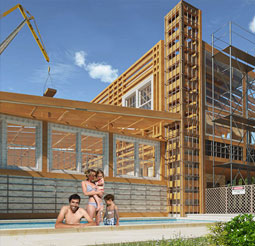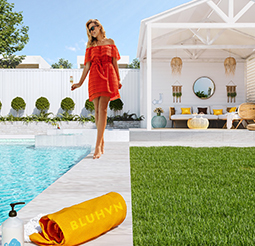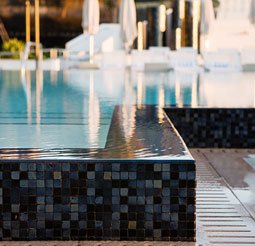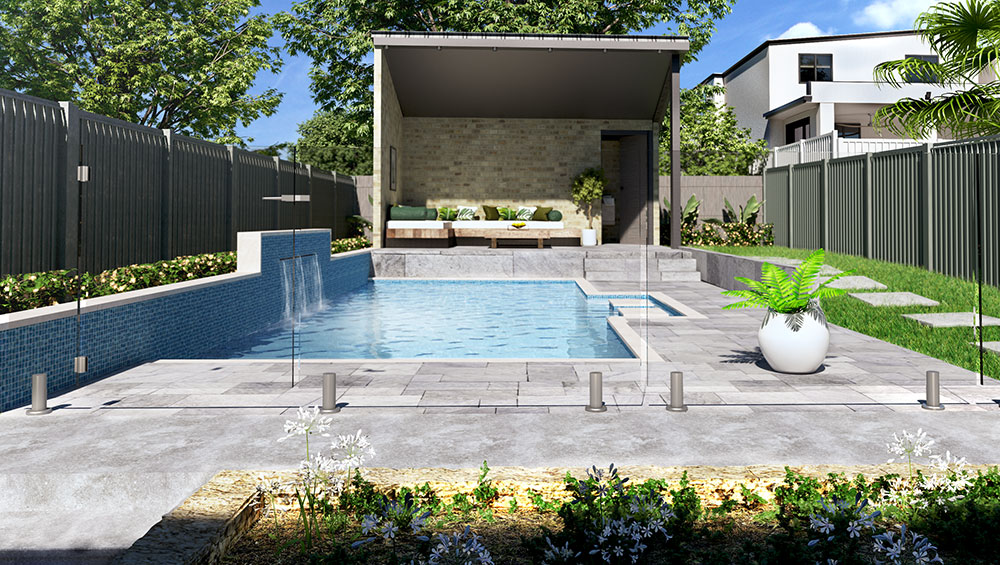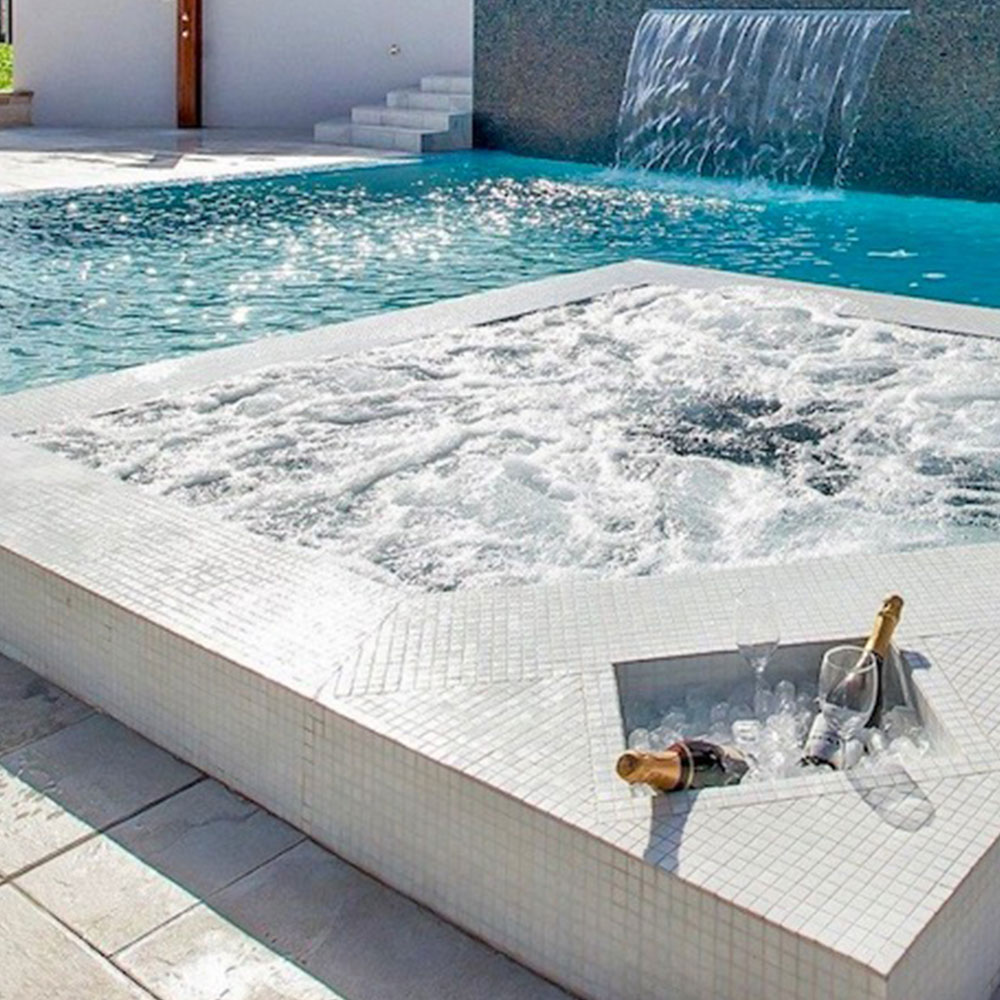Overcoming Challenges: Installing Pools on Sloping Ground
October 2, 2024
Building a home on sloping ground can be a blessing and a curse. On one hand, sloped land is often less expensive to buy, but that’s because building on it can come with additional expenses. When it comes to installing swimming pools on sloping ground, there are added complexities to consider as well, but that doesn’t make it impossible. In fact, as we’ll discuss in this article, there are actually significant benefits to installing a pool on sloped ground, provided you do it the right way.
In this article, we’re going to discuss all of the potential challenges of installing pools on sloping ground, and how you can ensure your installation is a success.
Complete a full site assessment
Before you even consider your pool installation, you should take every step to assess the site’s suitability. As pool construction experts, we know that a great pool can be built almost anywhere, but you need the right information before beginning.
Every sloping property is different, so you need to consider things such as the soil type, the gradient and several surrounding environmental factors. A crucial part of this process is identifying areas that may be prone to soil erosion or instability, as this can affect your pool’s foundations.
Choosing the right pool type for sloping ground
Once you’ve done a full site assessment, it’s time to choose the type of pool. For sloping terrains, concrete pools are usually more suitable as they can be customised to suit the existing environment. Fibreglass pools are certainly still an option, but installing one usually requires more earthworks and modifications, which can add to the cost.
Ultimately, there’s no right or wrong option, but it depends on the suitability of your site and of course, your budget. There are pros and cons for each type, but whether you choose a fibreglass or concrete pool, you’ll likely need a custom design unless you want to perform significant and costly earthworks to accommodate a prefabricated design.
Work with skilled excavation experts
Whether you choose concrete or fibreglass, you’ll still need site preparation and excavation to some degree. But if you thought installing pools on sloping ground was difficult, excavating sloping properties is just as hard. There is always the risk of soil shifting or collapsing, which can be extremely dangerous. That’s why you must always work with qualified, experienced professionals. Many people think they can save a few dollars by doing the excavation work themselves, but on a sloping block, the risk just isn’t worth the reward.
The importance of proper drainage
Once your pool is installed, it will require appropriate drainage. Water runoff can cause significant damage to both the pool and the surrounding area, and this is perhaps an even more vital consideration if you live in a climate with heavy rainfall. There are several options to ensure proper drainage, such as retaining walls (which we’ll touch on later) or other drainage systems that direct water safely away from the pool.
Drainage is always important for swimming pools, but even more so on sloping blocks where there may already be a risk of soil erosion or instability. Drainage ensures weather events don’t affect your pool’s structural integrity.
A focus on soil stability
Installing proper drainage is one way to ensure the soil around your pool remains stable, but it’s not the only way. If soil shifts, it can cause the pool to crack, split or even completely collapse. Protecting your pool from ground movement is perhaps the most important consideration when installing on sloping blocks.
Retaining walls are an excellent option. Ones with built-in drainage systems are even better. Essentially, a retaining wall helps to hold soil away from your pool’s immediate area. You can also consider working with landscaping experts to use the right types of vegetation, as root growth is another consideration when installing pools on complex terrain.
Using tiered levels to your advantage
You might think up until this point that building a pool on a sloping block is just too much hard work. Well, it’s a little more complicated, but there are also some advantages. For example, creating tiered levels using sloped terrain can create an interesting and highly functional pool design. You could have a shallow section for lounging and deeper sections for swimming.
A tiered approach also allows you to include impressive features such as steps and tanning ledges, and you can even incorporate surrounding decks or dining areas into the design. With skilled pool designers by your side, you can do anything.
Improve visual appeal with an Infinity Edge
Blue Haven offers Infinity Edge pools that are perfect for sloping blocks. More than just being supremely suited to the environment, Infinity Edge pools create a stunning visual effect. A well-designed Infinity Edge creates the illusion of water reaching the horizon, with pool edges that suddenly disappear. The sloping land actually enhances this effect, making Infinity Edge pools the perfect solution for difficult terrain. Why not use the landscape to your advantage and turn your backyard pool into a luxurious sanctuary?
Safety and fencing for pools on sloped sites
Needless to say, safety is paramount when designing any type of swimming pool. Sloped ground can increase the risk of falls, especially when combined with potentially wet surfaces. This is why your pool design must take into account the surrounding area. Non-slip surfaces, plenty of lighting and even features such as handrails can make your pool area safer and more accessible.
On the topic of accessibility though, you don’t want your pool area to be TOO accessible. You’ll still need to meet Australian pool fencing regulations. This can also add a layer of complexity to installing a pool on sloped ground, so ensure you work with fencing contractors who explicitly understand these laws.
Permits and regulations specific to sloping sites
With any type of construction project, even installing a pool, it’s worth checking with the local council about their guidelines. Different councils have different rules, so you can save yourself a lot of hassle and heartache by being informed. For example, the council may have specific regulations for sloping blocks, such as the mandatory use of retaining walls and specific drainage standards. Always check what types of approvals or permits you need before undertaking any type of construction.
Customised swimming pool access points
Another aspect to consider when installing a pool on sloping land is access points. In the safety section, we touched on the use of handrails to make the pool more accessible. But You might also consider what’s known as a ‘beach entry’. It’s essentially a very gradual slope into the pool and can be a good way to remove the need for steps.
Steps, however, can also be a consideration, especially for tiered swimming pools with interconnecting levels. But for pool entry, you can consider larger steps that offer a more gentle descent into the pool.
Long-term maintenance considerations
Once you’ve got your beautiful new pool installed, you still need to consider ongoing maintenance. Aside from all of the regular checks that you should do on your pool’s equipment and chemical levels, it’s worth doing some extra inspections for pools on sloped blocks.
Always carefully monitor the pool for signs of damage, such as cracks, surrounding soil erosion or even damage to retaining walls and drainage systems. All of these are crucial to maintaining your pool’s structural integrity, so it’s essential that these are checked regularly and repaired when necessary.
Picking up on minor issues today could end up saving you thousands of dollars in costly repairs. It’s not always too difficult to fix small problems with retaining walls or drainage systems, but if they’re left unrepaired, the problems only get worse and could even result in the total collapse of your pool.
Balancing costs and benefits
Overall, building a pool on a sloping block has plenty of advantages. You can create unique, aesthetically pleasing swimming pools that even include some incredible features. Depending on your budget, you’ve also got total control over the design and everything that it incorporates. Sloped land pools can be extremely luxurious, so there are plenty of reasons to consider one.
However, the process is certainly more costly due to the additional work required. You’ll need custom designs, expert installers and potentially significant earthworks. For most people, it’s all about weighing up the costs versus the benefits. A pool is always going to add value to your home, so if your family wants a backyard pool, don’t let some sloping land hold you back. Just always work with professionals with a proven track record of similar projects.
Want to know more about building a swimming pool on sloping ground?
Blue Haven has been designing and installing swimming pools in Australian homes since 1973. We can custom-design pools to meet your unique site requirements, whether it’s a sloping ground or a smaller space that requires a lap pool or a luxurious plunge pool. Our experts can design and install fibreglass or concrete pools on any property, with our expertise and attention to detail ensuring you can enjoy your family pool for years to come. Contact our friendly team today to discuss your needs.
Read More:

